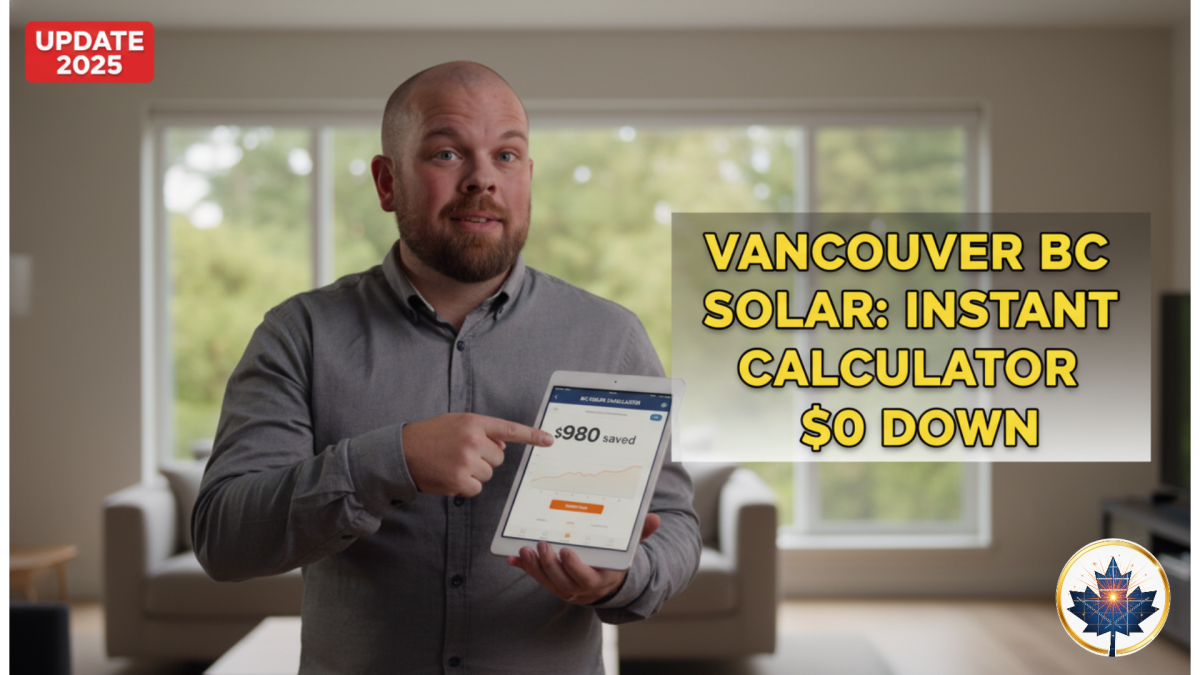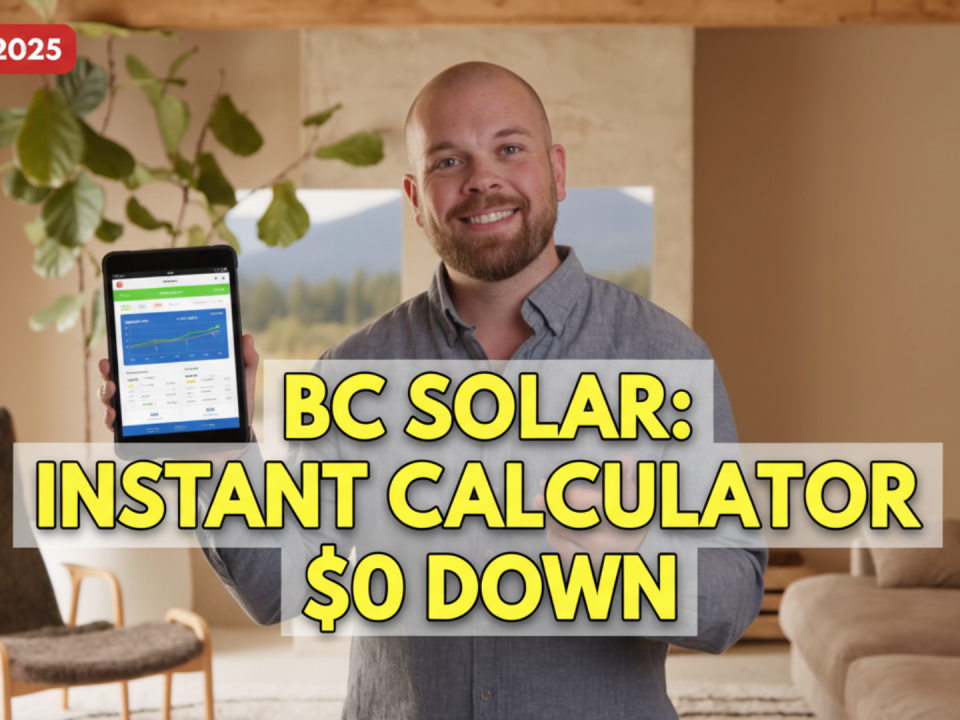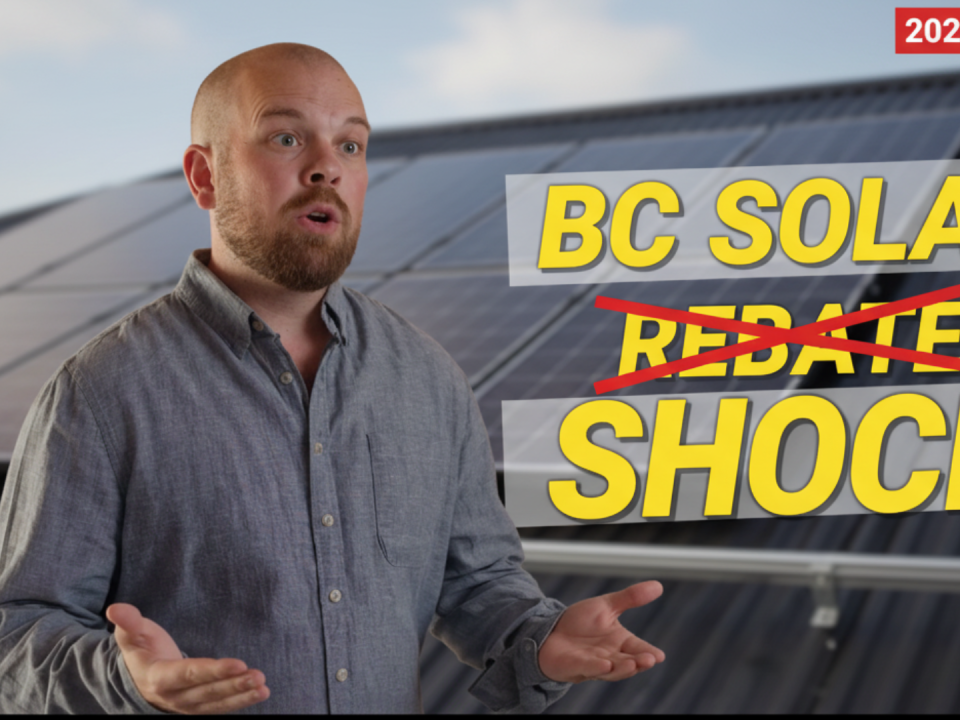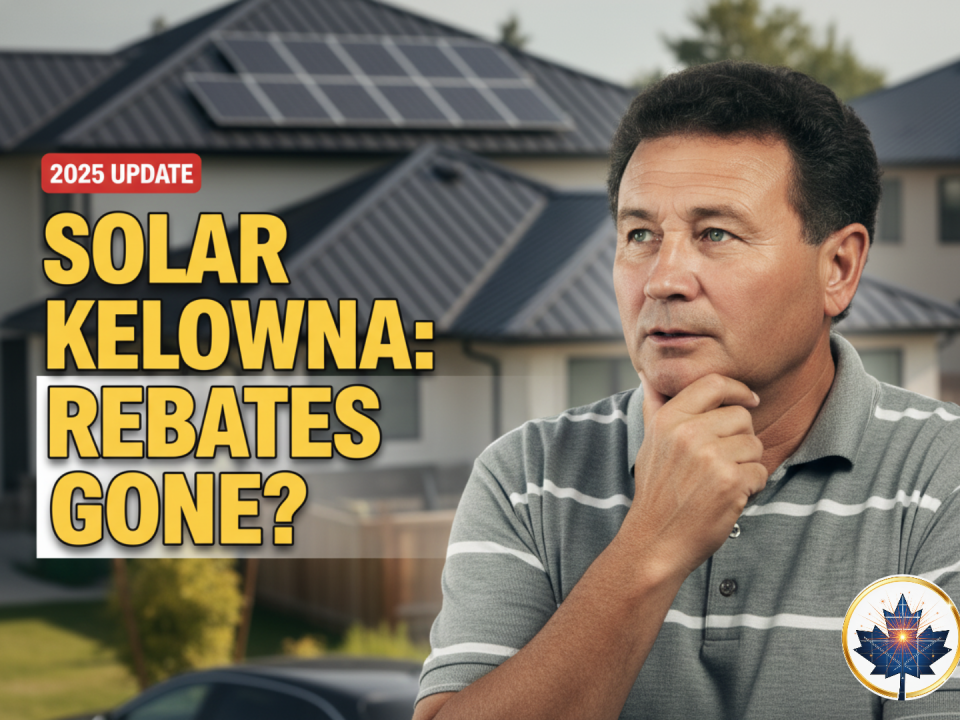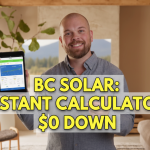
Cost Of Solar Panels in BC Calculator: Instant & Accurate + Incentives
October 23, 2025People ask me all the time: “Vitaliy, are solar panels in Vancouver really worth it?”
My answer is always the same: it’s a solid long-term investment, but the math has changed. It’s not a simple “yes” or “no” anymore. It depends on your finances, your home, and your patience.
This isn’t a sales pitch. This is a guide to the real costs, the lack of grants, the new financing headaches, and the exact step-by-step process for getting solar panels on your Vancouver roof. It’s a specific look at the city, but if you want the high-level overview, I’ve written a complete guide to solar panels in BC as well.
Is Going Solar in Vancouver Really Worth It in 2025?
Let’s get right to it. The decision used to be much easier. Today, it’s a tougher calculation.
Let’s Talk About the Elephant in the Room: The Greener Homes Grant is Gone
This is the biggest pain point for homeowners right now. The federal Greener Homes Grant and the associated 0% loan are closed. I’ve covered this extensively, but the Canada Greener Homes Grant is gone, and that’s the new reality.
This stings. It pushed the payback period for a solar PV system out by several years. Any company still advertising this grant on their website is either lazy or dishonest. That’s a huge red flag.
So, with that money gone, the entire financial case for solar in BC rests on one thing: net metering.
And to be perfectly clear: as of 2025, British Columbia has no provincial rebates for residential solar panels. I keep an updated list of solar power rebates in BC, and it’s frustratingly short. The PST exemption on solar equipment (see Bulletin PST 203) helps, but there is no direct grant from the province. This makes the federal grant’s loss hurt even more, and it makes understanding net metering your top priority.
Solution: We are happy to let you know that, working with us, you are eligible for a 0% down payment with 0% financing over 15 years. So this is a great deal.
The Real Payback: How BC Hydro’s Net Metering Works
This is the single most important program you need to understand. You can (and should) read the official BC Hydro Net Metering page for the fine print.
Here’s the simple version:
- Summer Gains: In June, July, and August, your solar array will produce way more electricity than your home uses.
- Bank Credits: This excess solar energy is sent “back to the grid.” BC Hydro gives you a credit for every kilowatt-hour (kWh) you send them.
- Winter Savings: In December and January, when it’s dark and rainy, your panels won’t produce much. You’ll draw power from the grid, just like you do now.
- The “Net”: BC Hydro applies your summer credits to your winter bills, effectively zeroing them out.
Sounds great, right? It mostly is. But here’s the critical catch: Your credits reset to zero every year on your anniversary date.
You do not get a cheque for any extra power you produce. This means the goal isn’t to build the biggest solar system possible. The goal is to size your system to produce exactly as much electricity as you use over 12 months (this is called “Net Zero”). (If you want a deeper dive, I’ve broken down how net metering in Canada works in another article.)
Tip for Sizing: Your installer must analyze your last 12 months of BC Hydro bills. If they just want to slap 30 panels on your roof without seeing your usage, walk away. They should be aiming to offset 90-100% of your annual kWh consumption, not 150%.
Vancouver’s “Rainy” Reputation: Does Solar Even Work Here?
This is the biggest myth I hear. In fact, I’ve written a whole post on solar panel myths Canadians still believe.
Let’s look at the data. Germany is a world leader in solar power, with over 82 GW of installed capacity. Vancouver gets more annual solar radiation (sunlight) than Berlin.
A properly installed 1-kilowatt (kW) solar PV system in the Metro Vancouver area will produce between 950 and 1,100 kWh of electricity per year, according to data from Natural Resources Canada (NRCAN).
Yes, production drops in the winter. But our long, bright summer days are perfect for harnessing the power of the sun and banking those net metering credits. Plus, the rain? It just cleans your panels for free, which actually makes them more efficient.
The Bottom Line: How Much Does Solar Panel Installation Cost in Vancouver?
This is the big number. Because the grant is gone, the upfront capital cost is the main hurdle.
The average cost of installing a solar system in British Columbia is typically between $2.30 and $3.00 per watt.
Average Solar System Costs
Here are some ballpark figures for a residential solar installation in Vancouver.
| System Size (kW) | Est. Annual Production (kWh) | Estimated Project Cost (Before Financing) |
|---|---|---|
| 4 kW | 4,000 – 4,400 kWh | $10,000 – $13,000 |
| 6 kW | 6,000 – 6,600 kWh | $14,000 – $18,000 |
| 8 kW | 8,000 – 8,800 kWh | $19,000 – $24,000 |
| 10 kW | 10,000 – 11,000 kWh | $23,000 – $30,000 |
| 12 kW | 12,000 – 13,200 kWh | $27,000 – $36,000 |
Disclaimer: This is an estimate. Your solar panel quote will be different. For a detailed breakdown for a home your size, you can see my complete solar system for home price guide.
What Factors Change Your Final Project Cost?
- Roof: A simple, south-facing roof is cheap. A steep, complex roof with dormers, multiple angles, or old shingles (that need replacing first) will cost more.
- Panels: Standard “Tier 1” panels are the workhorse. Premium, high-efficiency panels (like REC or LG) cost more but produce more power in a smaller space. If you’re curious about brands, I’ve reviewed the best solar panels in Canada for 2025.
- Inverter: You’ll have a choice between a central “string” inverter (one box on the side of your house) or “micro-inverters” (a small one under each panel). Micros cost more but are better for roofs with partial shading.
- Electrical Upgrades: If your home is older, you might need a new main panel to handle the solar connection. This can add $1,500 – $3,000.
The Financing Problem: How to Pay for It Now
Without the 0% federal loan, financing is a major pain point. Most solar companies offer financing through third-party lenders (like Financeit or SNAP). The rates can be high (8-13%), which can seriously damage your return on investment (ROI).
This is where you need to be strategic. I’ve written a guide on how to finance your solar panels now that explores these options, but the short version is:
- Secured Line of Credit: A HELOC (Home Equity Line of Credit) is almost always the cheapest way to borrow.
- Unique Installer Programs: This is a rare bright spot. As of late 2024/2025, I’m aware of one large installer in Canada, Polaron, that is still offering a 0% financing option for 5 years. They manage this internally, and it only requires a soft credit check. This is a massive advantage and makes their solar energy system much more accessible. Ask potential installers specifically about their financing rates.
Step-by-Step Guide: How to Go Solar in Vancouver
I’ve seen homeowners get really stressed about the process. The truth is, a good solar installer does 90% of the work for you.
Step 1: The Initial Quote and Site Assessment
- What you do: Call 2-3 experienced solar companies. Send them your BC Hydro bills.
- What they do: They’ll use satellite imagery (like Solargraf or Aurora) to design a preliminary system and give you a solar panel quote. This is usually free. If you like the quote, they’ll send someone to your home or business to measure your roof and check your electrical panel.
Step 2: Design, Engineering, and (The Fun Part) Permitting
- What you do: Sign the contract.
- What they do: This is where they earn their money. They create detailed engineering plans and submit all the permit applications to your city (North Vancouver, Langley, Vancouver proper, etc.) and, most importantly, to BC Hydro for the interconnection agreement. This part can take 4-8 weeks.
Step 3: The Installation
- What you do: Make sure your driveway is clear.
- What they do: The installation services crew (usually 2-4 people) shows up. For an average solar residential system, they’ll be done in 1-3 days. They install the racking, run the wiring, mount the solar panels, and install the inverter.
Step 4: Inspection and Connecting to the BC Hydro Grid
- What you do: Wait.
- What they do: The city inspector and/or an electrical inspector comes to approve the work. Once passed, the installer sends the final paperwork to BC Hydro. BC Hydro then gives the “Permission to Operate” and (in most cases) comes to swap your old meter for a bi-directional “net meter.”
Once that new meter is in, you are officially a renewable energy producer.
Finding the Right Vancouver Solar Installer
The installer is more important than the panel brand. A cheap panel installed well will last 25 years. A premium panel installed badly will be a 25-year headache.
I’ve had to help a few homeowners who got stuck after their installer went bust. The 25-year warranty on their panels was useless because the installing company was gone.
Red Flags to Watch For
- High-Pressure Sales: “This price is only good for today.” Run.
- Vague Quotes: If the quote doesn’t list the exact panel and inverter brand and model, ask for it.
- No Local Office: Avoid “fly-by-night” companies. A local Vancouver solar office means they’re invested and can provide support.
- Bad Reviews: This sounds simple, but read them. Look for complaints about customer support after the installation. This is a big purchase, and unfortunately, solar panel scams in Canada do exist.
Tip for Interviewing Installers: Ask these three specific questions (I have a full list of questions to ask solar companies if you want to be extra prepared):
- How long is your workmanship warranty? (This is separate from the 25-year panel warranty and covers leaks or install errors. Don’t accept less than 5 years.)
- Do you use your own crews or subcontractors? (In-house crews often mean more accountability and better communication.)
- What monitoring platform do you provide? (And who monitors it for alerts, you or me?)
What About Customer Support?
Your solar energy system should be maintenance-free for 25+ years. But what if a panel fails? What if your inverter throws an error? You need to know who to call. Ask potential installers about their support and monitoring. Do they actively monitor your system for you? Or is it on you to notice?
Do You Need a Battery Storage System?
Installers will almost always try to sell you a battery storage system (like a Tesla Powerwall or Enphase batteries).
Here’s my honest take: for 90% of Vancouver homeowners, a battery storage system is a luxury, not a financial necessity.
BC Hydro’s net metering program is your battery. It’s a “free” battery that is 100% efficient and never degrades.
The only reason to buy a physical battery storage system is for backup power. If you have a power outage, a standard grid-tied solar system must shut down by law (to protect utility workers). A solar with storage system can disconnect from the grid and use your panels and battery to power your home.
This resilience is amazing, but it adds $10,000 – $15,000+ to your project cost. It does not have a good ROI in British Columbia. You buy it for peace of mind, not to save more money.
Vitaliy’s Final Take: Is a Solar PV System Right for Your Home?
With no grants, the payback period for a solar panel installation in vancouver has probably stretched to 10-15 years, depending on your project cost and future BC Hydro rate hikes.
This isn’t a get-rich-quick scheme.
Installing solar panels is a long-term infrastructure investment. You’re pre-paying for 25+ years of clean energy at a locked-in price. You’re reducing your carbon footprint. And you’re gaining a high degree of energy independence.
It’s not for everyone. But if you have the means (or access to good financing) and plan to be in your home for at least 10 years, it’s one of the best upgrades you can make.
(Bonus) The Vancouver Solar Cost Calculator (Simplified)
Want to run the numbers yourself? Grab your BC Hydro bill and a calculator. (You can also just use my online solar panels calculator for a quick check.)
Step 1: Find Your Annual Usage (kWh) Look at your bill for your “Average Daily Use” in kWh.
- (Your Average Daily Use) x 365 = Your Total Annual Usage (kWh).
- Example: 25 kWh/day x 365 = 9,125 kWh per year.
Step 2: Size Your System You need a system that produces that amount of electricity. We know 1 kW of panels makes ~1,000 kWh per year in Vancouver.
- (Your Total Annual Usage) / 1,000 = Your Ideal System Size (kW).
- Example: 9,125 kWh / 1,000 = 9.125 kW. Let’s call it a 9 kW system.
Step 3: Estimate Your Cost Use an average cost of $2.70/watt (or $2,700 per kW).
- (Your System Size in kW) x 1,000 x $2.70 = Your Estimated Total Cost.
- Example: 9.125 kW x 1,000 = 9,125 watts. 9,125 x $2.70 = $24,637.
Step 4: Calculate Your Simple Payback Find your annual electricity cost.
- (Your Total Annual Usage) x (Your “Step 2” Rate) = Your Annual Savings.
- BC Hydro’s Step 2 rate is ~ $0.14 per kWh.
- Example: 9,125 kWh x $0.14 = $1,277 saved per year.
- (Your Estimated Total Cost) / (Your Annual Savings) = Simple Payback (in Years).
- Example: $24,637 / $1,277 = ~19.3 years.
Note: This 19.3-year payback looks long, but it’s a conservative calculation. It assumes your electricity cost never changes. We all know BC Hydro rates go up. As they do, your annual savings ($1,277) also go up, and your payback time shrinks. This calculation also doesn’t include financing costs, which would lengthen it. This is why paying with cash or a low-rate HELOC is key.
This is just an estimate, but it gives you a realistic, non-sugar-coated idea of the long-term finances.

